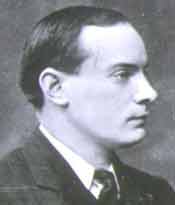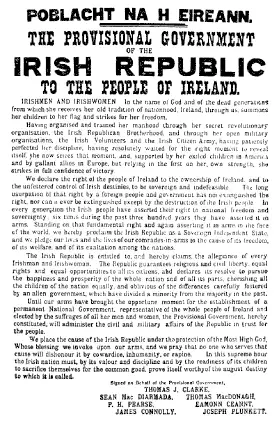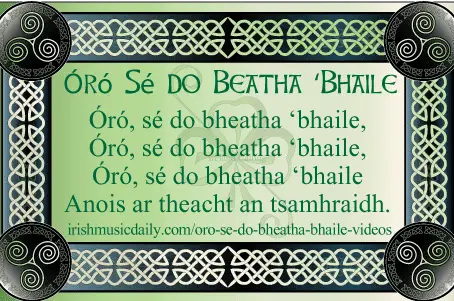Óró Sé do Bheatha ‘Bhaile was a rallying call for Irish nationalism for nearly 300 years.

Óró Sé do Bheatha ‘Bhaile Translations
Óró Sé do Bheatha ‘Bhaile Videos
Lyrics and Chords
Story of Granuaile – symbol of Ireland
Irish rebels used the song as a marching tune during in the 1916 Easter Rising and has remained popular ever since.
Director Ken Loach put the song before a worldwide audience when he featured it in the misty, atmospheric marching scene in his 2006 film, The Wind That Shakes the Barley.
Two versions of Óró Sé do Bheatha ‘Bhaile

There are two versions of Óró Sé do Bheatha ‘Bhaile. They are both sung to the same tune but have different lyrics.
The original version dates back to the 18th century and the Jacobite Rebellion, which aimed to overthrow the Protestant English monarchy and place the Catholic Bonnie Prince Charlie on the throne.
The Irish supported Prince Charlie. They thought that if they helped him, he would remove the English landowners who had taken over so much Irish land.
The song Óró Sé do Bheatha ‘Bhaile welcomes Charles to Ireland and looks forward to him leading a successful rebellion and banishing all the English from Ireland.
However, the Jacobite Rebellion didn’t succeed. Prince Charles failed to meet Irish expectations as a leader and liberator.
Granuaile replaces Charles in modern version

Padraig Pearse wrote the modern version of Óró Sé do Bheatha ‘Bhaile.
Pearse – who was one of the leaders of the 1916 Easter Rising in Ireland – liked the song as an Irish rallying call but wasn’t happy with Charles as a figurehead.
For a start, Charles was Scottish and more importantly, he was a loser, having failed in his bid to become king.
He felt that a song about a failure like Charles would hardly inspire confidence in the next generation of Irish rebels as they prepared for the 1916 Easter Rising.
Pearse removed Charles from the song and turned instead to Granuaile – the Irish “Pirate Queen” whose real life exploits had become the stuff of legend in Ireland.
Granuaile was a symbol of Ireland and Irish resistance
Granuaile was a larger than life character who became the most famous woman in Ireland in the second half of the 16th century. She was intelligent and charming at the same time as being a ruthless military leader.
She led a large band of sailors and clan warriors who ruled the seas off the West Coast of Ireland for more than half a century.
Granuaile went under various titles including Sea Queen of Connaught and the Pirate Queen. She fought against the occupation of Ireland and was twice imprisoned by the English.
Despite all their efforts, the English could not defeat her or break her spirit. This this made her a legendary figure. She became a symbol both of Ireland itself and of Irish refusal to submit to a foreign power.
Pearce put Granuaile at the heart of Irish resistance
Pearce wanted to evoke that defiant spirit when he rewrote the lyrics to Óró Sé do Beatha ‘Bhaile.
Pearce’s version of the song removes Bonnie Prince Charlie and replaces him Granuaile, a true, native Irish figurehead.
The song now welcomes Granuaile home and refers to her imprisonment, which is mirrored by the effective imprisonment of the Irish people who saw their land being usurped by the English.
They’re Irishmen – not French or Spanish
Pearce emphasises that his Easter Rebellion will be a home grown affair. He refers symbolically to Granuaile coming over the sea to Ireland’s rescue with armed warriors who are “Irish – not French or Spanish.”
This is a direct reference to the old Jacobite version of Óró Sé do Beatha ‘Bhaile which referred to Prince Charlie coming with French and Spanish warriors. That rebellion failed but this time Ireland’s fate would be in the hands Irish warriors.
Symbolic appeal to Irish soldiers in the British Army

Pearce wasn’t just indulging with symbolic references to a mythical past; he was dealing in the present and looking to the future.
The song welcomes home the spirit of rebellion in the shape of Granuaile. It also has a more down to earth purpose in reaching out the 200,000 Irish soldiers who were fighting with the British Army against Germany during the First World War.
Pearse thought it a supreme irony that Irishmen were fighting for the right of small nations to be free when they weren’t free themselves in their own country.
Many Irish nationalists at the time shared this belief.
Pearse believed that if only some of those soldiers could be persuaded to fight on the side of the rebels, then independence would be achieved for certain. The brilliantly reflective song, The Foggy Dew explores this theme further.
Oro Se do Bheatha ‘Bhaile uses old Irish melody
Pearse’s version of Óró Sé do Bheatha ‘Bhaile retains the old Irish melody used in the original version.
By the end of 19th century, the tune had been used for the sea shanty, What Shall We do with a Drunken Sailor. Indeed, that was the song with which the melody was most closely associated for many people.
Pearce’s rewrite changed that. His version of Óró Sé do Bheatha ‘Bhaile became immensely popular with Irish nationalists both immediately before and after the 1916 Easter Rising. It remains popular and well known in Ireland today.
See here for translations
Óró Sé do Bheatha ‘Bhaile
Óró Sé do Bheatha ‘Bhaile Translations
Óró Sé do Bheatha ‘Bhaile Videos
Lyrics and Chords
Story of Granuaile – symbol of Ireland
